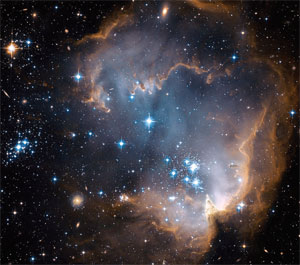Story behind Palomar documents Hale’s quest
By Steve Koppesskoppes@uchicago.edu
News Office
 Photos by NASA/STSci The documentary “Journey to Palomar” is the story of American astronomer George Ellery Haleís public and private struggle to build the four largest telescopes of the 20th century. |
|
Palomar Observatory stands six stories high atop the 5,600-foot Palomar Mountain in southern California. From an airplane, the observatory’s dome looks like a tiny white dot.
“But the story behind it is just monumental,” said Robin Mason, who with husband Todd Mason has produced a new documentary, “The Journey to Palomar.” The film tells the story of George Ellery Hale’s quest to build the largest telescopes of his day. It will air at 10 p.m. Monday, Nov. 10, on WTTW Channel 11.
Hale’s quest took him from his home observatory at 4545 Drexel Blvd. in Chicago’s Kenwood neighborhood, to a professorship at the newly founded University of Chicago, then the establishment of Yerkes Observatory in Wisconsin, and later the Mount Wilson and Palomar observatories in southern California.
The Masons provided a special screening of “The Journey to Palomar” at the University on a crisp and overcast day in December 2006.
“Hale’s life, in retrospect, seems like a series of endless successes,” Todd Mason told the audience in the Ida Noyes Library Lounge. “But in reality, it was an endless series of trials and really endless failures that he overcame.”
Longtime astronomy enthusiasts, the Masons undertook “The Journey to Palomar” at the encouragement of their friend Craig Hogan, Professor in Astronomy & Astrophysics. When they began their research, they knew little about the story waiting to be told. “We just fell in love with the whole thing,” said Robin Mason.
The Masons marveled at the technological wizardry of the Palomar telescope that Hale developed. It weighed a million pounds but could be moved with the push of a hand. “Then we discovered the magic behind the story, which is Hale,” said Todd Mason.
 |
|
Hale raised money from the nation’s richest men in order to build the world’s most powerful telescopes. The successful targets of his fundraising included, in succession, Chicago’s “goliath of graft”—Charles Yerkes, Andrew Carnegie and John D. Rockefeller Jr.
Debilitating headaches, anxiety and bouts of deep depression plagued Hale amid his financial and technical struggles, yet he enjoyed periods of “titanic energy,” Todd Mason said. “He could walk into a room and just light it up, and everyone wanted to be his best friend. But then it would exhaust him.” Within hours, Hale would retreat to his darkened room, where he would remain for days at a time.
Among his achievements, Hale confirmed the existence of carbon in the sun, showing that Earth and sun consist of similar elements. He also discovered the sun’s magnetic field. “If you understand the secrets of the sun, the solutions to the stars will follow,” became the mantra of Hale’s lectures.
“He had an almost mystical fascination with the sun,” said Todd Mason.
Hale’s career culminated with Palomar’s 200-inch telescope, a project that dominated his final years. From a journalistic standpoint, the telescope project was the 1930s equivalent of the Apollo moon landings, according to historian Kevin Starr.
When time came to ship the mirror from the Corning Glass Works in New York to California by railroad, crowds turned out to witness the occasion.
Hale died in 1938, a decade before the telescope began operation. Named after Hale at its dedication in June 1948, the telescope remained the world’s largest for decades. Once one of the world’s most famous scientists, Hale slowly faded from public memory.
Nevertheless, his contributions were monumental, like the giant telescope that bears his name. “He put the physics in astrophysics,” said Rocky Kolb, Professor and Chairman of Astronomy & Astrophysics.
For more information, see http://www.pbs.org/thejourneytopalomar or http://www.journeytopalomar.org/.
![[Chronicle]](/images/sidebar_header_oct06.gif)